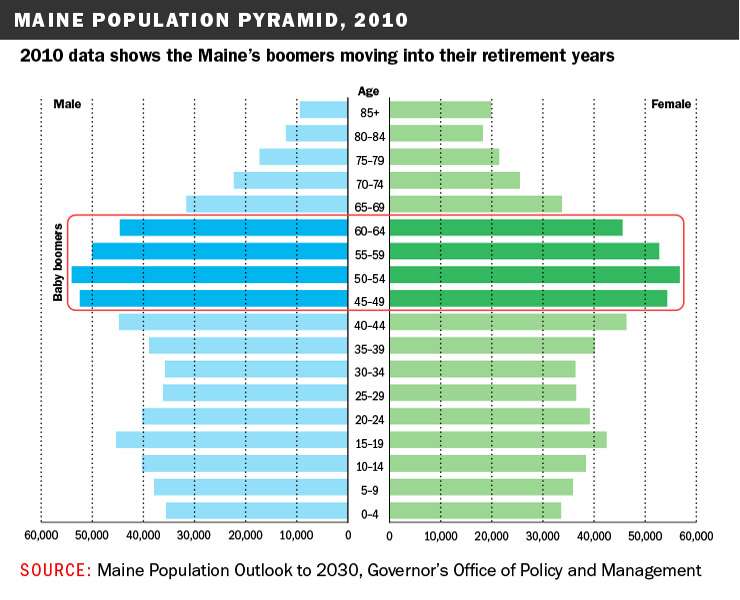
Maine’s demographic challenge: The population is static — and getting older
 From nearly every industry, there’s the cry of, “We can’t find workers.”
From nearly every industry, there’s the cry of, “We can’t find workers.”
Maine’s economy in recent years has been overshadowed by its so-called demographic problem.
The state’s population is the oldest in the country, with a median age of 43.8 years old. Florida has more old people, but Maine has the edge when it comes to median age. Add to that a population that has grown only slightly, hovering just over 1.3 million, and we have a recipe for some demographic issues.
Baby boomers who flooded into Maine in the 1960s and ’70s are now retiring, selling businesses and leaving professions. In areas of the state, hospitals are closing maternity wards.

Immigrants have not had the impact on northern New England’s population that they’ve had in other states. The issues that affect Maine are even worse in Vermont, which has fewer than half the number of people.
As a result, from nearly every industry, there’s the cry of, “We can’t find workers.”
- There are fewer construction workers, so that slows the pace of construction and increases the cost. At the same time, there’s less demand for new homes, so the number of building permits is nearly half what it was in the early 2000s.
- Nurses are in great demand because of two factors: The existing pool of nurses, like the rest of Mainers, is getting older and wants to retire. At the same time, the aging pool of residents needs more health care — and more nurses. The Maine Nursing Action Coalition is working hard to fill the gap, but even by 2025, there will still be a shortage of 2,700 registered nurses.
- Lawyers are getting older and Maine has fewer to start. Nationally, there are 40 lawyers per 10,000 people; in Maine there are 30 per 10,000 people, according to the University of Maine Law School. As of 2017, about 1,000 of the 3,700 practicing lawyers in Maine were 60 or older. In rural parts of the state, 65% of lawyers are older than 50. As they retire, fewer younger practitioners are replacing them.
- There are fewer students. There were 182,496 students in the current academic year, compared to 192,181 in 2008-09, according to the Maine Department of Education. That puts a greater burden on the school system. Efforts to consolidate or close schools have been met with fierce complaints.
- Fewer high school students means fewer students going into the University of Maine System. That, in turn, has prompted the UMaine System to recruit more out-of-state students.
- Trade workers, from plumbers to electricians to HVAC specialists, are aging out. Even though there are fewer manufacturing jobs overall, skilled workers like welders are in demand. Employers are pressed to find more workers. Community colleges are struggling to produce enough skilled workers to meet demand. “There’s clearly a need for plumbers, for electricians, for HVAC, for computer technology — all of these positions are in demand. Welding is very hot right now. All of these professions are good-paying jobs,” Richard Hopper of Kennebec Valley Community College, recently told Mainebiz.
- Maine’s forest products industry still contributes more than $8.5 billion to the state’s economy, and yet the shortage of loggers and log truckers has gotten so acute it’s become a threat to the industry, the Maine Center for Business and Economic Research at the University of Southern Maine reported recently.
Going forward, the debate might revolve around whether to try to recruit more immigrants. The conversation may come back to job creation. In any case, for the foreseeable future, Maine is facing a demographic challenge.









0 Comments